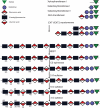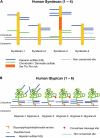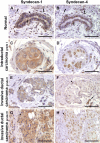Breast and ovarian cancers: a survey and possible roles for the cell surface heparan sulfate proteoglycans
- PMID: 22205677
- PMCID: PMC3283135
- DOI: 10.1369/0022155411428469
Breast and ovarian cancers: a survey and possible roles for the cell surface heparan sulfate proteoglycans
Abstract
Tumor markers are widely used in pathology not only for diagnostic purposes but also to assess the prognosis and to predict the treatment of the tumor. Because tumor marker levels may change over time, it is important to get a better understanding of the molecular changes during tumor progression. Occurrence of breast and ovarian cancer is high in older women. Common known risk factors of developing these cancers in addition to age are not having children or having children at a later age, the use of hormone replacement therapy, and mutations in certain genes. In addition, women with a history of breast cancer may also develop ovarian cancer. Here, the authors review the different tumor markers of breast and ovarian carcinoma and discuss the expression, mutations, and possible roles of cell surface heparan sulfate proteoglycans during tumorigenesis of these carcinomas. The focus is on two groups of proteoglycans, the transmembrane syndecans and the lipid-anchored glypicans. Both families of proteoglycans have been implicated in cellular responses to growth factors and morphogens, including many now associated with tumor progression.
© The Author(s) 2012
Conflict of interest statement
The authors declared no potential conflicts of interest with respect to the authorship and/or publication of this article.
Figures




Similar articles
-
Heparan Sulfate Proteoglycans Can Promote Opposite Effects on Adhesion and Directional Migration of Different Cancer Cells.J Med Chem. 2020 Dec 24;63(24):15997-16011. doi: 10.1021/acs.jmedchem.0c01848. Epub 2020 Dec 7. J Med Chem. 2020. PMID: 33284606
-
Heparan sulfate proteoglycans in Drosophila neuromuscular development.Biochim Biophys Acta Gen Subj. 2017 Oct;1861(10):2442-2446. doi: 10.1016/j.bbagen.2017.06.015. Epub 2017 Jun 20. Biochim Biophys Acta Gen Subj. 2017. PMID: 28645846 Review.
-
Prognostic impact of the glypican family of heparan sulfate proteoglycans on the survival of breast cancer patients.J Cancer Res Clin Oncol. 2021 Jul;147(7):1937-1955. doi: 10.1007/s00432-021-03597-4. Epub 2021 Mar 19. J Cancer Res Clin Oncol. 2021. PMID: 33742285 Free PMC article.
-
Specific genes involved in synthesis and editing of heparan sulfate proteoglycans show altered expression patterns in breast cancer.BMC Cancer. 2013 Jan 17;13:24. doi: 10.1186/1471-2407-13-24. BMC Cancer. 2013. PMID: 23327652 Free PMC article.
-
Heparan Sulfate Proteoglycans in Human Colorectal Cancer.Anal Cell Pathol (Amst). 2018 Jun 20;2018:8389595. doi: 10.1155/2018/8389595. eCollection 2018. Anal Cell Pathol (Amst). 2018. PMID: 30027065 Free PMC article. Review.
Cited by
-
Biomolecular analysis of matrix proteoglycans as biomarkers in non small cell lung cancer.Glycoconj J. 2018 Apr;35(2):233-242. doi: 10.1007/s10719-018-9815-x. Epub 2018 Mar 3. Glycoconj J. 2018. PMID: 29502190
-
Focus on PD-1/PD-L1 as a Therapeutic Target in Ovarian Cancer.Int J Mol Sci. 2022 Oct 11;23(20):12067. doi: 10.3390/ijms232012067. Int J Mol Sci. 2022. PMID: 36292922 Free PMC article. Review.
-
N6-methyladenosine-modified circPLPP4 sustains cisplatin resistance in ovarian cancer cells via PIK3R1 upregulation.Mol Cancer. 2024 Jan 6;23(1):5. doi: 10.1186/s12943-023-01917-5. Mol Cancer. 2024. PMID: 38184597 Free PMC article.
-
Early diagnosis of breast and ovarian cancers by body fluids circulating tumor-derived exosomes.Cancer Cell Int. 2020 May 24;20:187. doi: 10.1186/s12935-020-01276-x. eCollection 2020. Cancer Cell Int. 2020. PMID: 32489323 Free PMC article. Review.
-
An oncolytic adenovirus regulated by a radiation-inducible promoter selectively mediates hSulf-1 gene expression and mutually reinforces antitumor activity of I131-metuximab in hepatocellular carcinoma.Mol Oncol. 2013 Jun;7(3):346-58. doi: 10.1016/j.molonc.2012.10.007. Epub 2012 Nov 7. Mol Oncol. 2013. PMID: 23182495 Free PMC article.
References
-
- Aikawa J-I, Grobe K, Tsujimoto M, Esko JD. 2001. Multiple isoenzymes of heparan sulfate/heparin GlcNAcN-deacetylase/GlcN N-sulfotransferase. J Biol Chem. 276:5876–5882 - PubMed
-
- Alexander CM, Reichsman F, Hinkes MT, Lincecum J, Becker KA, Cumberledge S, Bernfield M. 2000. Syndecan-1 is required for Wnt-1 induced mammary tumorigenesis in mice. Nat Genet. 25:329–332 - PubMed
-
- Allred DC. 2010. Issues and updates: evaluating estrogen receptor-alpha, progesterone receptor, and HER2 in breast cancer. Mod Pathol. 23(Suppl 2):S52–S59 - PubMed
-
- Antonnen A, Heikkila P, Kajanti M, Jalkanen M, Joensuu H. 2001. High syndecan-1 expression is associated with favourable outcome in squamous cell lung carcinoma treated with radical surgery. Lung Cancer. 32:297–305 - PubMed
-
- Arvatz G, Shafat I, Levy-Adam F, Ilan N, Vlodavsky I. 2011. The heparanase system and tumor metastasis: is heparanase the seed and soil? Cancer Metastasis Rev. 30:253–268 - PubMed
Publication types
MeSH terms
Substances
LinkOut - more resources
Full Text Sources
Other Literature Sources
Medical

